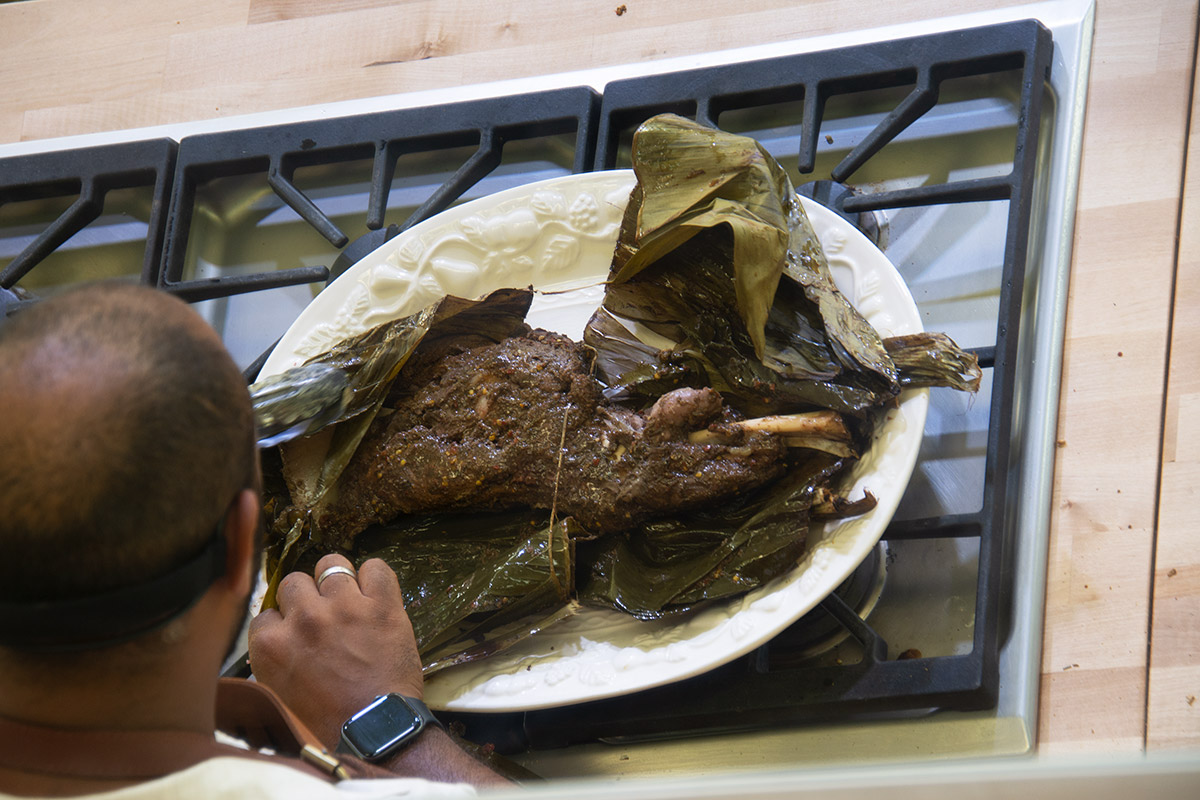Omani Recipe: Slow-Cooked Lamb Shuwa

Mommin Al Rawahi prepared his marinated, slow-cooked lamb daily at the 2022 Folklife Festival.
Photo by Stanley Turk, Ralph Rinzler Folklife Archives
Growing up, Mommin Al Rawahi watched his mother and grandmothers cook, admiring the way they brought people together around food. Now, at age thirty-one and working as an engineer by day and a certified home chef by night, he wishes to do the same, building valuable memories while sharing Omani cooking with people around the world.
Al Rawahi’s specialty is shuwa, a traditional Omani dish of slow-cooked, marinated lamb or goat. His version of Omani-style pit-roasted lamb—using his great-grandmother's method, passed down by his grandfather—is not a dish for one, or even for a nuclear family. He remembers the whole family preparing the dish for the festive season, describing it as akin to a American Thanksgiving dinner.
“One person does not make the lamb,” he says. “Everybody makes the lamb.”
Passionate about feeding his adopted community in the United Arab Emirates, Al Rawahi now raises his own lamb and invites anyone to come eat, especially those for whom lamb is not readily affordable. Traditionally, the dish is a whole lamb cooked in a pit in the earth, wrapped in banana leaves and placed in a sack for two to three days. Many families have their own pits for one lamb at a time, but more commonly neighbors maintain a large community pit. Identifying whose lamb is whose can be a problem, so people mark their sacks with their license plate number or even by placing a can of their favorite soda on top. Since communities are tightly knit, these personalized touches make them easily identifiable.
Every family will also have their own marinade, called khamar al shuwa, to season the meat. The wet spice mix is usually prepared and stored in five-gallon tanks for use throughout the year, especially during the festive season. As it sits, the spices get stronger and better incorporated. The adapted recipe below will make a large batch, and Al Rawahi encourages readers to try it with a variety of meat and vegetable dishes.

Since this meal is traditionally cooked in the earth, and in such large quantities, adapting this recipe for the Smithsonian Folklife Festival was somewhat of a challenge—digging a pit in the National Mall is generally frowned upon! For his demonstrations, Al Rawahi wrapped lamb shoulder in banana leaves and foil and cooked it in a smoker for five hours. If you have a smoker at home, this dish could be an exciting addition to your barbecue repertoire. He also adapted a recipe that can be cooked in just two hours in a pressure cooker.
“If my grandfather saw me do this, he would say I was taking shortcuts,” Al Rawahi confessed, but he also admitted that this pressure cooker lamb shoulder is an excellent dish, suitable for a smaller family, any day of the week. Even without the smoker, the toasted cumin and coriander impart a delicious smokiness and the banana leaves leave a wonderfully earthy quality that recalls the large community pits that Al Rawahi fondly remembers from his childhood in Oman and recreates in his current home in the UAE.
Ingredients
Spice Mix
1 tablespoon whole cumin seeds
1 tablespoon whole coriander seeds
½ tablespoon salt
½ tablespoon ground cinnamon
1 teaspoon ground turmeric
2 teaspoons red chili flakes (adjust to desired heat level)
1 tablespoon black pepper
1 tablespoon ground cardamom
1 tablespoon ground ginger
1 tablespoon ground clove
1 loomi (dried lime), ground
1 head garlic, minced
1 tablespoon date vinegar (or substitute apple cider vinegar)
2 tablespoons tamarind paste
2 tablespoons white vinegar
Lamb
1 lamb shoulder
Dried banana leaves (or substitute parchment paper)
¼ cup honey (optional dipping sauce)


Preparation
For the spice mix: heat a small frying pan on medium-high heat for about 1 minute. Place whole cumin and coriander seeds in the pan and toast together for about 3 to 4 minutes, or until the seeds start to open slightly.
Place the toasted spices into a spice grinder and pulse 1 to 2 times, taking care to maintain a coarse grind, as this will form a nice crust around the meat during the cooking process.
Add the rest of the spices and vinegar into a mixing bowl to combine. Place in a container and set aside.
For the lamb: if using banana leaves, wipe them clean with a wet paper towel and lay flat.
Place the lamb shoulder on a cutting board. Using a boning knife, remove some of the skin on the shoulder. It is important not to remove too much as the skin will cook with the spices to create that delicious crust. Using a utility knife, cut several small holes all over both sides of the lamb to ensure that the spices can get inside the meat.
Place the marinated lamb onto the center of the banana leaves or parchment paper. Take the prepared spice mix and begin to marinate to your desired level of spice. Massage the shuwa into the lamb on both sides and then carefully wrap the lamb until it is fully covered.
Place the wrapped lamb into a pressure cooker with about ½ cup water. Set the pressure cooker to the highest temperature and pressure setting and cook for 2 hours. When finished, unwrap and plate the lamb with the optional side of honey.
Kathryn Casey is the 2022 Folklife Festival foodways assistant and a graduate student of cultural studies and folklore at George Mason University. Her love of food comes from a long family tradition of wonderful home cooks as well as a decade’s experience working in food service.

